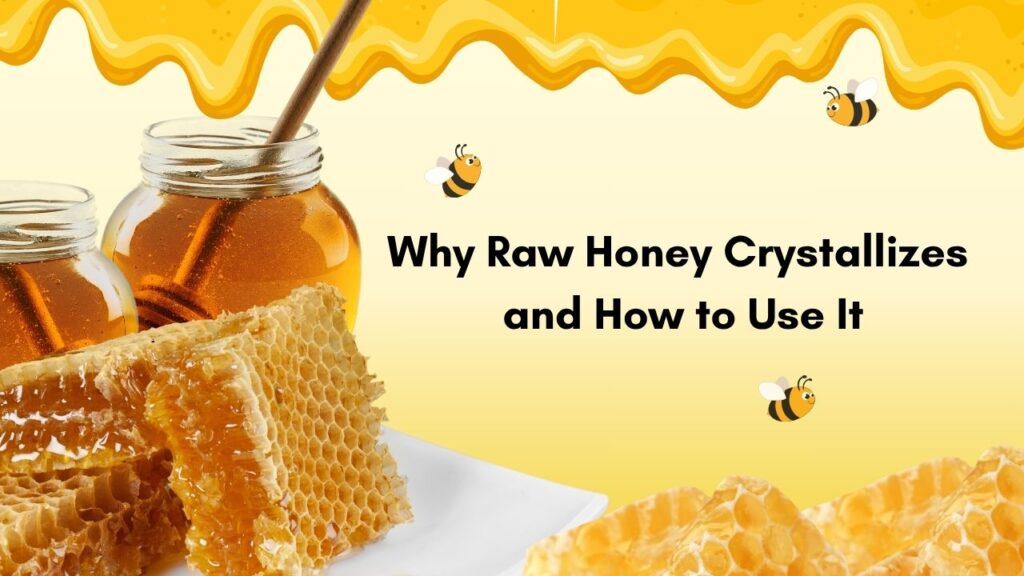If you’ve ever bought a jar of raw honey only to see it turn thick or grainy over time, you’re not alone. Many people wonder why raw honey crystallizes – and whether it’s gone bad. The truth? Crystallization is a natural and even desirable process. In fact, it’s a sign that your honey is raw, pure, and minimally processed. In this guide, we’ll explain exactly why raw honey crystallizes and how you can still enjoy it to the fullest.
What is Crystallization in Raw Honey?
Crystallization is the process by which the natural sugars in raw honey, primarily glucose, separate from water and form crystals. This makes the honey look cloudy or solidify over time. It’s a completely natural phenomenon and happens more quickly in raw honey because it contains pollen, enzymes, and fine particles that act as a foundation for crystals to form.
You can read more about Raw Honey in What is Raw Honey? Everything You Need to Know
Why Does Raw Honey Crystallize?
There are several reasons why raw honey crystallizes:
- High Glucose Content: Honey varieties with higher glucose levels (like mustard or clover honey) crystallize faster.
- Cool Temperatures: Cold environments accelerate crystallization. Storing honey below room temperature can cause it to solidify quicker.
- Presence of Natural Particles: Bee pollen, enzymes, and propolis in raw honey offer surfaces for crystals to form — unlike filtered processed honey.
- Low Water Content: Less water means higher sugar saturation, leading to quicker crystallization.
Is Crystallized Raw Honey Safe to Eat?
Absolutely! In fact, crystallized honey is often easier to spread and has a more intense, grainy texture that some people prefer. Crystallization does not affect the quality or health benefits of raw honey — it simply changes the texture.
How to Decrystallize Raw Honey
If you prefer smooth, liquid honey, you can gently restore it with heat — without destroying its nutritional value.
Here’s how to do it properly:
- Place your honey jar in a bowl of warm water (not boiling) and let it sit for 20–30 minutes.
- Stir occasionally to help dissolve the crystals.
- Avoid microwaving or boiling, as high heat can destroy enzymes and antioxidants in raw honey.
Repeat this process if necessary, but always use low heat.
How to Use Crystallized Raw Honey
Crystallized raw honey can be used in the same ways as liquid honey. In fact, it works better in some situations:
- Spread it on toast like a natural jam.
- Mix into hot beverages where it dissolves quickly.
- Use in baking recipes where texture doesn’t matter.
- Add to marinades and dressings for a sweet, tangy twist.
- Create face masks where thickness adds to the application ease.
How to Prevent Crystallization (If You Want To)
While you can’t stop raw honey from crystallizing forever, you can slow it down:
- Store honey in a warm place (around 21–27°C or 70–80°F).
- Keep the jar tightly sealed to avoid moisture.
- Use glass jars instead of plastic.
But remember, crystallization is not spoilage — it’s a sign that you’ve bought authentic, raw honey!
FAQs: Raw Honey Crystallization
- Is crystallized raw honey still healthy?
Yes, it retains all the health benefits of raw honey. - Does crystallization mean my honey is fake?
No, it’s the opposite. Real raw honey crystallizes. - Can I microwave crystallized honey?
It’s not recommended — use warm water instead. - Why does some honey crystallize faster?
It depends on the flower source and glucose content. - Can I use crystallized honey in tea?
Yes, it melts easily in hot liquids. - Will crystallization affect the taste?
Not really, though texture changes slightly. - Should I throw away crystallized honey?
No — it’s still perfectly good to eat. - Does processed honey crystallize?
Rarely, because it’s heated and filtered. - What’s the best way to store raw honey?
In a sealed glass jar at room temperature. - Can I eat raw honey crystals directly?
Yes, they’re sweet, crunchy, and safe.
Conclusion
The crystallization of raw honey is one of the best indicators of its purity and authenticity. Instead of being alarmed by its changing texture, embrace it. Whether liquid or solid, raw honey is full of natural goodness that supports your health, taste buds, and lifestyle.
You may also like: Raw Honey vs. Processed Honey – Key Differences Explained

